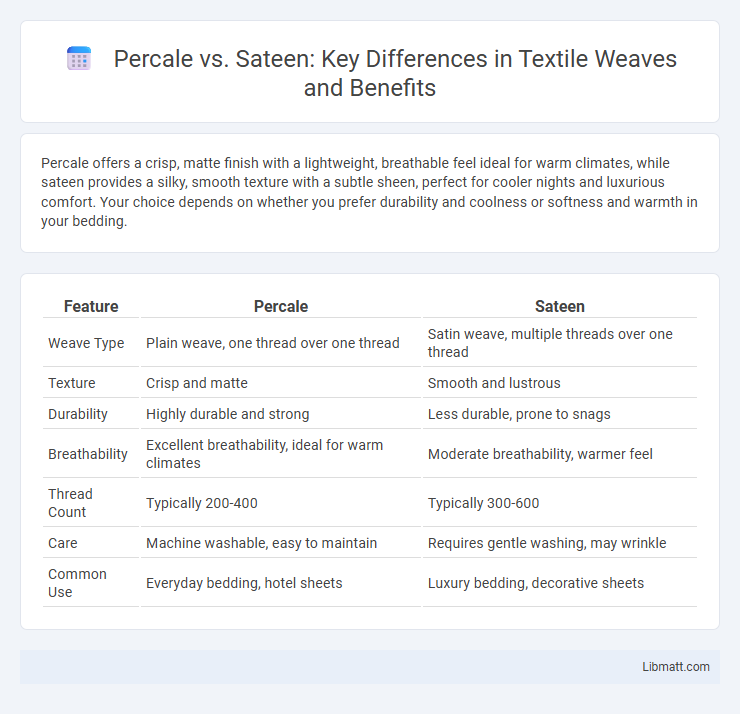Percale offers a crisp, matte finish with a lightweight, breathable feel ideal for warm climates, while sateen provides a silky, smooth texture with a subtle sheen, perfect for cooler nights and luxurious comfort. Your choice depends on whether you prefer durability and coolness or softness and warmth in your bedding.
Table of Comparison
| Feature | Percale | Sateen |
|---|---|---|
| Weave Type | Plain weave, one thread over one thread | Satin weave, multiple threads over one thread |
| Texture | Crisp and matte | Smooth and lustrous |
| Durability | Highly durable and strong | Less durable, prone to snags |
| Breathability | Excellent breathability, ideal for warm climates | Moderate breathability, warmer feel |
| Thread Count | Typically 200-400 | Typically 300-600 |
| Care | Machine washable, easy to maintain | Requires gentle washing, may wrinkle |
| Common Use | Everyday bedding, hotel sheets | Luxury bedding, decorative sheets |
Introduction to Percale and Sateen
Percale is a closely woven fabric made from cotton or cotton blends, known for its crisp, matte finish and breathable texture, making it ideal for warm sleepers and everyday use. Sateen, woven with a satin weave, features a smooth, lustrous surface with a soft hand feel, offering a luxurious appearance and enhanced warmth. Both percale and sateen are popular choices in bedding due to their distinct weaving techniques and durability characteristics.
What Is Percale?
Percale is a tightly woven cotton fabric known for its crisp, matte finish and smooth texture, commonly used in bedding for its durability and breathability. This plain weave features a one-over, one-under pattern, resulting in a lightweight and cool feel that enhances comfort during warm nights. Your choice of percale sheets ensures long-lasting softness and a fresh, airy sleep environment.
What Is Sateen?
Sateen is a type of woven fabric characterized by a smooth, glossy surface created through a satin weave that places more warp threads on the fabric surface. Typically made from long-staple cotton fibers, sateen offers a soft, luxurious feel with a slight sheen that enhances bedroom aesthetics. Compared to percale, sateen is less breathable but provides greater warmth and a silkier texture, making it ideal for cooler climates or those seeking a lustrous appearance.
Key Differences: Percale vs Sateen
Percale features a crisp, matte finish with a tight plain weave of one-over-one-under, resulting in a lightweight, breathable fabric ideal for hot sleepers. Sateen uses a four-over-one-under weave that creates a silky, smooth surface with a subtle sheen, offering a warmer and more luxurious feel. Key differences include percale's durability and coolness versus sateen's softness and slight lustrous appearance, making each suited to different sleep preferences and seasonal uses.
Weave and Texture Comparison
Percale fabric features a plain weave with a one-over, one-under pattern that creates a crisp, matte finish and a lightweight, breathable texture ideal for warm climates. Sateen fabric utilizes a satin weave, typically a three-over, one-under pattern, resulting in a smooth, lustrous surface with a silkier feel and more substantial weight. The difference in weave structure directly influences the texture, with percale offering a cool, crisp touch and sateen providing a soft, luxurious hand.
Breathability and Temperature Regulation
Percale features a crisp, plain weave that offers superior breathability and excellent temperature regulation, making it ideal for hot sleepers or warm climates. Sateen has a denser weave with a silky finish, which traps more heat and provides a warmer, cozier feel. Your choice should prioritize percale for cooler airflow and sateen for a softer, warmer sleep experience.
Durability and Longevity
Percale sheets are known for their durability due to their tightly woven, plain weave construction, which resists wear and tear over time and maintains crispness after many washes. Sateen sheets, while luxuriously smooth with a satin-like finish, feature a denser satin weave that is more prone to snagging and showing signs of wear more quickly than percale. The longevity of percale generally surpasses that of sateen, making it a preferred choice for those seeking long-lasting, breathable bedding.
Comfort and Feel
Percale fabric offers a crisp, cool, and breathable texture ideal for hot sleepers, characterized by its matte finish and lightweight feel. Sateen fabric provides a smooth, silky surface with a lustrous sheen, delivering a warmer and more luxurious sensation against the skin. The choice between percale and sateen hinges on preference for a fresh, airy comfort versus a soft, satin-like experience.
Best Uses and Recommendations
Percale sheets, known for their crisp texture and breathability, are ideal for hot sleepers or warm climates, providing a cool and comfortable night's rest. Sateen sheets offer a smooth, silky feel with a subtle sheen, making them perfect for cooler seasons or those who prefer a luxurious, soft touch against their skin. Your choice depends on whether you prioritize temperature regulation with percale or a cozy, elegant experience with sateen.
Which Is Right for You?
Percale offers a crisp, lightweight feel with a matte finish, ideal for hot sleepers or those who prefer breathable bedding. Sateen provides a silky, smooth texture with a slight sheen, perfect if you enjoy a luxurious, warmer sleep surface. Your choice depends on whether you value cool, breathable comfort or a soft, elegant touch in your sheets.
Percale vs Sateen Infographic

 libmatt.com
libmatt.com